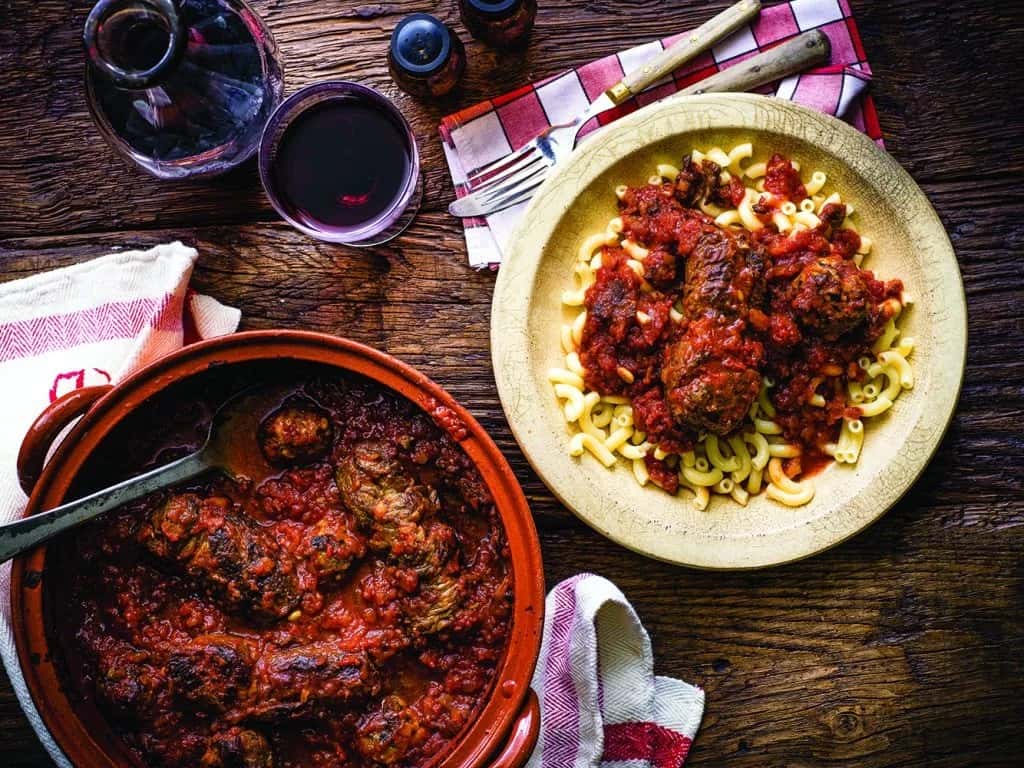Soutzoukakia is one of the most popular dishes in Greek cuisine.
Many reports have been written about the origins of soutzoukakia, the most prevalent being their roots in Asia Minor, especially in Smyrna. After all, the term “sujuk” in Turkish means sausage, referring to the long, narrow shape reminiscent of a small sausage.
Greek refugees and genocide survivors coming to Greece modified the recipe, removing the animal intestine that was used as a casing, enriching it with the aromas of the local cuisine and replacing the minced lamb with beef.
Cumin, the key ingredient

As every fanatical consumer of this dish knows, soutzoukakia are intertwined with two magical ingredients: garlic and cumin. Success lies precisely in these key ingredients of the recipe.
Cumin gives soutzoukakia their characteristic, earthy taste. According to traditional accounts, it goes mainly in the sauce, but for those who love oriental flavours, I’d say it goes just as well in the minced meat mixture.
Garlic is an integral part of the recipe, not only for its flavour but also for its emulsifying properties, which help bind the ingredients in the mixture.
Cooking techniques for perfect results
The process of making them is just as important as the ingredients. The preparation of the mixture is crucial to achieve fluffy soutzoukakia.
Soaking the bread in bay leaves adds a deep, sweet note to the mix, while the use of wine during shaping makes them fluffy and juicy. The mixture is kneaded carefully until it becomes foamy and left in the refrigerator for a while to stabilise its texture.
The onion is absent so as not to dominate the taste of the meat and spices but also to help the consistency of the mixture.
Cooking: Frying or baking?

The soutzoukakia are fried in extra virgin olive oil to obtain a golden and crispy crust through the Maillard reactions that will take place. Alternatively, they can be baked in the oven for those who want a “lighter” result, but the traditional flavour comes out only with frying.
Be careful with the flour. If you want crispness, flour before frying, but this can lead to the absorption of an additional amount of olive oil during frying.
Alternatively, you can flour them after sautéing before putting them in the sauce so that you can help the tomato sauce bind more easily through the starch.
The art of tomato sauce
The tomato sauce, flavoured with garlic, allspice, and cumin, should be thick and rich in flavour. It takes about 25 minutes to set and for our soutzoukakia to boil in it.
If you have followed the traditional shaping of the soutzoukakia, i.e. their size is small, it is good to let the sauce cook on its own and add them 15 minutes before the end of cooking. This ensures that our meat will remain tender but will also absorb all the necessary aromas.
An even tastier way is to transfer the food to a deep pan and finish cooking in the oven.
Nutritional value and health benefits

Soutzoukakia is not only tasty but also nutritious. Adding olive oil enhances the intake of monounsaturated fatty acids, which are known for their cardioprotective effect.
Cumin and garlic combine their antioxidant and anti-inflammatory properties, contributing to the overall nutritional value.
Soutzoukakia is a culinary treasure of the Eastern Mediterranean.
The art of their preparation is not only a matter of tradition but also of science. Every material and technique has its importance, so every bite is a special culinary experience.
Maria Papakonstantinou is a columnist for Cantina. Translated by Paul Antonopoulos.
READ MORE: Keftedes: The Science Behind Perfect Greek Meatballs.

